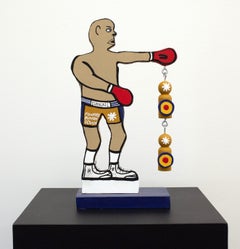Folk Art Art
2010s Folk Art Art
Metal
2010s Folk Art Art
Metal
2010s Folk Art Art
Metal
Mid-20th Century Folk Art Art
Oil, Board
21st Century and Contemporary Folk Art Art
Cotton, Digital
20th Century Folk Art Art
Crayon, Pastel, Paper, Graphite
Mid-20th Century Folk Art Art
Paint
Mid-20th Century Folk Art Art
Paint
Mid-20th Century Folk Art Art
Paint
Mid-20th Century Folk Art Art
Paint
2010s Folk Art Art
Paper, Ink
2010s Folk Art Art
Paper, Acrylic
21st Century and Contemporary Folk Art Art
Wood, Paper, Mixed Media, Oil, Acrylic
Late 19th Century Folk Art Art
Metal
1990s Folk Art Art
Acrylic, Charcoal, Paper
1990s Folk Art Art
Wood, Acrylic
1990s Folk Art Art
Paper, Acrylic
1990s Folk Art Art
Paper, Charcoal
1990s Folk Art Art
Acrylic, Paper, Charcoal
1990s Folk Art Art
Charcoal, Acrylic, Paper
1990s Folk Art Art
Monoprint, Paper
1990s Folk Art Art
Paper, Monoprint
Early 2000s Folk Art Art
Pastel, Paper, Charcoal
Early 2000s Folk Art Art
Paper, Charcoal, Acrylic
1990s Folk Art Art
Oil, Panel
1940s Folk Art Art
Screen
1990s Folk Art Art
Canvas, Oil
1970s Folk Art Art
Canvas, Paint
21st Century and Contemporary Folk Art Art
Charcoal, Color Pencil
21st Century and Contemporary Folk Art Art
India Ink
1940s Folk Art Art
Screen
1940s Folk Art Art
Screen
2010s Folk Art Art
Stoneware, Glaze, Underglaze
2010s Folk Art Art
Concrete
Early 2000s Folk Art Art
Charcoal, Paper, Acrylic
Early 2000s Folk Art Art
Paper, Acrylic, Charcoal
1940s Folk Art Art
Screen
1940s Folk Art Art
Screen
1940s Folk Art Art
Screen
1940s Folk Art Art
Screen
1970s Folk Art Art
Canvas, Oil
Late 20th Century Folk Art Art
Canvas, Oil
20th Century Folk Art Art
Oil, Plywood
1960s Folk Art Art
Oil
2010s Folk Art Art
Ceramic, Earthenware
2010s Folk Art Art
Wood, Acrylic
Late 20th Century Folk Art Art
Linen, Oil
1960s Folk Art Art
Wood, Paint
1960s Folk Art Art
Wood
2010s Folk Art Art
Ceramic, Clay
1970s Folk Art Art
Rag Paper, Etching, Aquatint
1870s Folk Art Art
Textile
1970s Folk Art Art
Canvas, Oil
1870s Folk Art Art
Lithograph
1970s Folk Art Art
Rag Paper, Etching, Aquatint
1970s Folk Art Art
Paper, Etching, Aquatint
1970s Folk Art Art
Canvas, Oil



